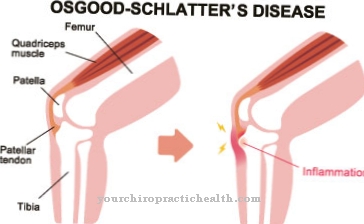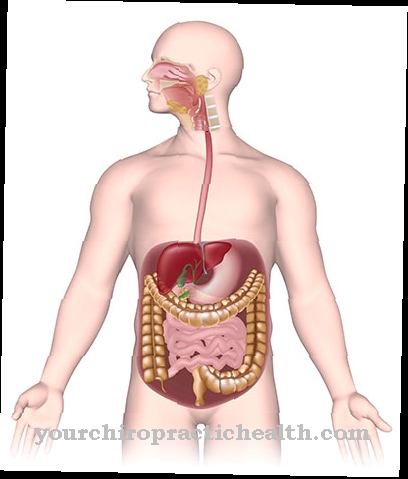The Hypermobility syndrome (HMS) is characterized by an excessive flexibility of the joints, which is caused by a congenital weakness of the connective tissue. Little is known about the cause of the disease. The quality of life is particularly limited by chronic pain in the joints.
What is Hypermobility Syndrome?

© gritsalak - stock.adobe.com
At the Hypermobility syndrome it is a connective tissue weakness, which leads to an unusual overmobility of the joints. The disease is characterized by overstretchability of the joints. The distinction between normal mobility and hypermobility is fluid. The syndrome is associated with complaints in the musculoskeletal system, but these must be differentiated from rheumatic diseases.
HMS must also be viewed separately from other diseases that are associated with hypermobility of the joints, such as Marfan syndrome, rheumatoid arthritis, osteogenesis imperfecta or Ehlers-Danlos syndrome. With regard to Ehlers-Danlos syndrome, however, there are discussions as to whether hypermobility syndrome is a mild variant of this disease. Despite the benign course, the complaints severely impair the quality of life. As the disease occurs very rarely, there is very little experience with its causes and effects.
causes
Very little is known about the causes of hypermobility syndrome. In 1986 it was included in the International Nosology of Hereditary Diseases of Connective Tissue. There are contradicting statements in the literature. It is said to be an autosomal dominant hereditary disease. However, the affected gene is not mentioned. Other publications do not assume an inheritable disease.
It is also not clear to what extent the syndrome can be distinguished from other diseases. Some researchers suspect links to Ehler-Danlos syndrome, with HMS being a mild variant of this disease. In this syndrome, an autosomal dominant inheritance is known.
Symptoms, ailments & signs
The main symptom of hypermobility syndrome is the overmobility of the joints up to their hyperextension. In small children this hypermobility is still physiological because the connective tissue is not yet fully developed at this age. During puberty, the joints complete maturation and their range of motion usually decreases. However, this is not the case with hypermobility syndrome.
On the contrary, mobility even increases. The syndrome is defined according to the so-called Beighton Score. The Beighton Score is a point system that describes the extent of hyperextension. There is a point when the hyperextensibility of an elbow is greater than 10 degrees, the thumb touches the forearm, the base joint of the little finger can be stretched to 90 degrees, the hyperextensibility of the knee joint is greater than 10 degrees and the palms of the hands are stretched Kneel on the floor. If there are four or more points, there is a hypermobility syndrome.
Generalized hypermobility is only of pathological value if it is accompanied by chronic pain, arthralgia, soft tissue rheumatism in more than three places, neurological and psychological problems and other symptoms. Symptoms may or may not appear. Overall, the clinical picture is very variable. Some toddlers have difficulty learning to walk.
In other people, the first symptoms do not appear until puberty. The common symptom is the progressive progression of the disease. Life expectancy is usually normal with the exception of the rare cases where vascular involvement is noted.
Diagnosis & course of disease
To diagnose hypermobility syndrome, differential diagnoses must be carried out to distinguish it from other diseases. These conditions include Marfan's syndrome, rheumatoid arthritis, fibromyalgia, normal growing pains, and Ehlers-Danlos syndrome. However, according to some definitions, there is some overlap with Ehlers-Danlos syndrome.
Complications
The hypermobility syndrome severely restricts and reduces the quality of life. The affected person usually suffers from severe pain, which mainly affects the joints. This also results in restricted mobility, so that the patient may also be dependent on the help of other people in everyday life. The mobility of the joints decreases and leads to severe restrictions.
As a result, normal everyday activities or sporting activities are no longer easily feasible for the patient. The joints can also be hyperextended. The pain can also occur in the form of pain at rest and thereby lead to sleep disorders. The hypermobility syndrome usually does not lead to a reduction in life expectancy, but the syndrome progresses over time and leads to increasingly severe symptoms.
As a result of the persistent pain, it is not uncommon for the patient to experience depression and other mental disorders. It is not possible to treat the hypermobility syndrome causally. For this reason, only symptomatic treatment is given. This does not lead to further complications or complaints. However, it cannot be predicted whether the treatment will also lead to a positive course of the disease.
When should you go to the doctor?
A doctor should be consulted as soon as there is any discomfort or pain in the skeletal system. If there are changes in mobility and abnormalities in the range of motion, a doctor should examine the physical conditions more closely. If the joints are overmovable or overstretchable, there are often diseases that have a creeping course of the disease. Therefore, a doctor should be consulted as soon as possible.
If the person concerned is not performing well or has the feeling of a loss of strength, a doctor should be consulted. With rheumatic complaints, the disease is already in an advanced stage. Therefore, in these cases, a doctor should be consulted immediately. If physical activities can no longer be performed as usual, if there is inner restlessness or if the person concerned often feels exhausted, a clarification of the complaints is advisable.
If you feel sick, feel unwell or have psychological problems, a check-up visit to a doctor is highly recommended. If the symptoms persist for several weeks or months, there is cause for concern. If they increase in intensity or extent, the person concerned needs medical help and medical care. If children have unusual problems learning to move about, it is advisable to discuss the observations with a doctor. If you are refused to run or continue to restrict yourself, you should see a doctor.
Doctors & therapists in your area
Therapy & Treatment
A causal therapy of the hypermobility syndrome is not possible. However, four groups of complaints must be treated individually. These include:
- the orthopedic problems
- the pain treatment
- the effects on the nervous system
- the blood vessel changes
The orthopedic problems must be treated differently than with classic rheumatic diseases. Reluctance is with surgical To practice surgical procedures because ligament tightening is often unsuccessful and impaired scarring occurs. In fact, muscle building exercises are counterproductive. The focus is on building up depth stability. Contact sports and often repetitive activities should be avoided. For this, gentle forms of training should be carried out without overstretching.
If nerve clamps occur more often due to muscle tension, the use of neck pillows or cervical braces makes sense. The blood vessel system should also be observed in order to be able to react quickly to the first signs of impending circulatory disorders in the brain. Since pain affects the quality of life the most, the main focus should be on pain therapy.
Pain therapy consists of talk therapy, relaxation techniques and the intake of weak opiates such as tilidine, tramadol and codeine. In the case of depression, a combination with pain relieving antidepressants is also useful. Behavioral therapy should encourage behaviors that make it easier to deal with the disease and develop strategies to minimize its effects.
The variability of the disease makes it necessary to develop individual strategies to cope with the problems. Addressing hypermobility syndrome is a lifelong process.
Outlook & forecast
The prognosis of the hypermobility syndrome is described by doctors as unfavorable. Although the life expectancy is not shortened by the disturbances, it comes to severe impairments in the accomplishment of the everyday duties. The chronic disease is based on a genetic defect and is therefore considered incurable. Scientists and researchers have no legal authority to modify a person's genetics. For this reason, the medical treatment of the disease is limited to the treatment of the existing complaints.
The symptoms are individual, but focus on the human musculoskeletal system. In addition, they usually increase over the course of life. In a large number of patients, the limitations of the disease develop psychological sequelae or illnesses. The burden of physical deficits is transferred to the emotional level and leads to a reduction in wellbeing. Overall, this makes possible treatment successes more difficult and can also exacerbate existing symptoms. In many cases, patients are dependent on the help of other people on a daily basis, since they cannot cope with everyday life on their own. Feeling helpless can trigger frustration, behavior problems, or changes in personality. In addition, the person concerned suffers from severe pain. The active ingredients of analgesic preparations cause addictive behavior and trigger further secondary diseases.
prevention
There is no way to prevent hypermobility syndrome as it is most likely a congenital connective tissue defect. However, everything should be done to avoid secondary diseases through the wide range of therapy options. This includes building up the deep stability of the joints through gentle forms of training, monitoring blood vessels to avoid circulatory disorders or strokes, preventing nerve entrapment using a neck brace and pain therapy.
Aftercare
In most cases of hypermobility syndrome, the affected person has only a few direct follow-up measures available. Since it is also a congenital disease, it cannot be completely cured, so that the patient is dependent on lifelong therapy. If the person concerned wants to have children, genetic counseling can also be carried out.
This will help determine how likely the children are to develop the disease. The focus of hypermobility syndrome is early detection and treatment so that there are no further complications or complaints. As a rule, the symptoms of hypermobility syndrome are treated with physiotherapy or pain therapy.
The affected person can do many exercises from these therapies in their own home and thereby accelerate the treatment. The help and support of your own family or friends is also very important with this illness and can above all prevent depression or other psychological upsets. In some cases, however, professional psychological support is necessary. The life expectancy of the person affected is not negatively influenced or otherwise reduced by the hypermobility syndrome.
You can do that yourself
In the case of hypermobility syndrome, some complaints can also be limited by means of self-help, so that medical treatment does not always have to take place.
In the case of muscle tension, special pillows and other aids can be used to prevent and treat them. Exercises to relax the muscles and the body can also be used in hypermobility syndrome, whereby yoga is particularly suitable for this. However, strenuous activities or sporting activities should be avoided in order not to overload the body and muscles. Above all, exercises that build muscle should be avoided. Pain therapy should also be carried out for this syndrome. This therapy is usually carried out as directed by a doctor. However, the person should avoid pain relievers whenever possible, as these may damage the stomach if taken over a long period of time.
In the case of depression and other psychological complaints caused by hypermobility syndrome, a psychologist should always be contacted. However, conversations with relatives or friends can also have a positive effect on the course of the disease. Those affected are also dependent on regular blood vessel and blood circulation examinations to prevent possible complications and disorders.



.jpg)

-durch-vitamin-b12-mangel.jpg)
.jpg)




















